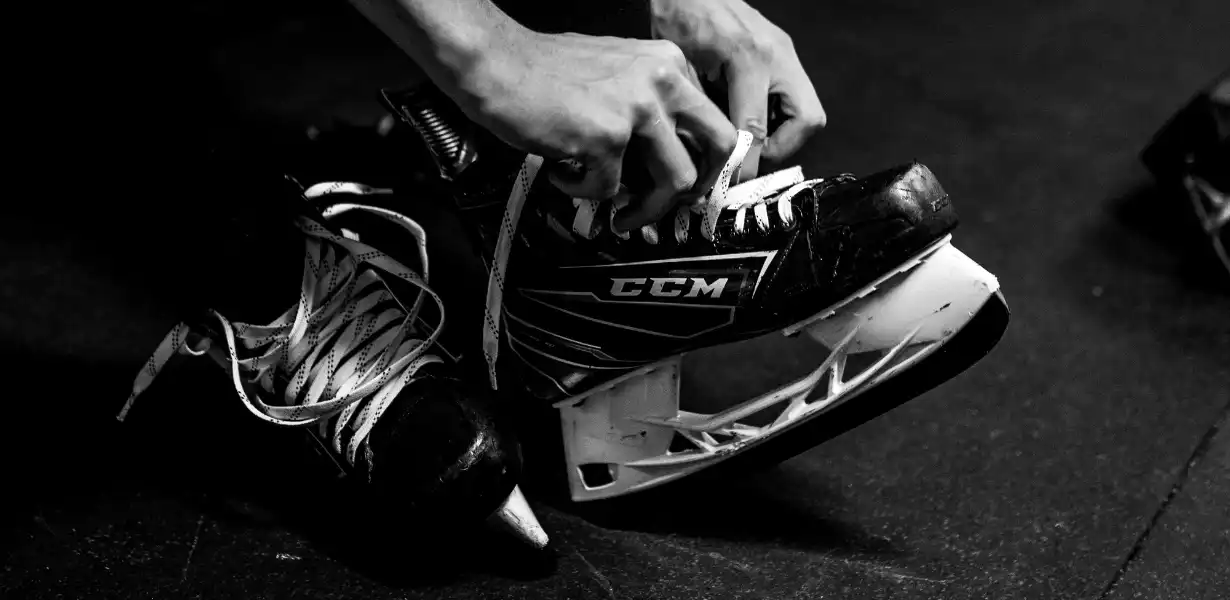Ask any hockey player about their skate sharpening, and you’ll get a passionate answer. From youth leagues to the pros, every skater has a preferred feel under their blades. The debate usually centers on two main styles—traditional hollow sharpening and flat bottom V (FBV) sharpening.
Each approach changes how the skate interacts with the ice, influencing grip, glide, and overall performance. While both methods can produce excellent results, understanding how they differ helps players make an informed choice that complements their skating style.
The Traditional Hollow Grind
The hollow grind—often called the radius of hollow (RoH)—has been the standard method for decades. A circular grinding wheel shapes a concave groove into the blade, forming two edges that dig into the ice.
The Role of Radius
That groove’s depth is measured in inches, commonly 3/8”, 1/2”, or 5/8”. The smaller the number, the deeper the hollow and the sharper the edge bite.
• Deeper hollow (3/8”): More grip and stopping power, ideal for sharp turns.
• Shallower hollow (5/8”–3/4”): Smoother glide and less resistance, better for fast, flowing skating.
This trade-off is well established. Sparx Hockey and Bauer both confirm that deeper hollows give more bite, while shallower hollows improve glide by reducing drag.
Advantages
✅ Customizable to individual skating style and rink conditions
✅ Reliable grip and predictable edge feel
✅ Available in nearly every pro shop
Limitations
❌ Increased drag from deeper cuts
❌ Frequent sharpening required to maintain consistency
❌ Edge feel can vary slightly between sharpeners or rinks
Flat Bottom V (FBV) Sharpening
The Flat Bottom V, introduced by Blackstone Sport, is a more recent innovation. Instead of a fully concave shape, FBV leaves a flat center channel with two raised edges. This design reduces surface friction and aims to combine glide efficiency with stable edge hold.
According to Blackstone’s official documentation, the flat area lessens drag, allowing the skate to glide more easily, while the edges maintain enough bite for maneuverability.
How FBV Works
FBV sharpening uses specialized “spinners” that determine both the flat width and the edge depth, described by measurements like 90/75 or 100/50. Each setting balances bite and glide differently—roughly comparable to traditional hollow depths.
For example:
• 90/75 FBV ≈ similar bite to a 3/8” hollow
• 100/50 FBV ≈ closer to a 5/8” hollow
Advantages
✅ Often delivers a smoother, faster glide (as reported by users and manufacturers)
✅ Maintains edge control for quick turns
✅ Removes less steel per sharpening, extending blade life
Limitations
❌ Requires a sharpener equipped with FBV technology
❌ Edge durability and feel can vary depending on player weight and ice temperature
❌ Some users report that FBV edges may be more sensitive to nicks
The Science Behind the Edge
Both sharpening methods influence how the blade contacts the ice.
• Hollow Sharpening: Creates two edges with more pressure per contact point, improving bite but increasing resistance.
• Flat Bottom Sharpening: Spreads contact across a flatter surface, reducing drag and energy loss.
Physics supports the idea that less contact can reduce friction, but the benefit isn’t identical for all players. The feel depends on body weight, skating mechanics, and ice hardness.
Independent testing on FBV performance is limited, though both players and sharpening technicians consistently report differences in glide and energy return.
Choosing What Fits Your Game
For Speed and Flow
Skaters who rely on acceleration and smooth transitions often enjoy the feel of FBV. The glide efficiency can make it easier to maintain top speed with less effort—especially on firm, cold ice.
For Grip and Stability
Players who prefer solid edge control—such as defensemen or goalies—often stay with traditional hollow sharpening. It’s familiar, predictable, and ideal for precise stops or physical play.
For Changing Ice Conditions
• Hard ice: Deeper hollows or higher-bite FBV settings give extra grip.
• Soft ice: Shallower hollows or flatter FBV profiles help reduce drag.
Many sharpening professionals recommend adjusting settings during the season rather than sticking to a single setup.
Common Misunderstandings
“FBV Sharpening Always Lasts Longer.”
Not necessarily. Some players experience longer edge life, but others report faster dulling when the edge gets nicked. Edge longevity depends on ice conditions, steel hardness, and skating intensity, not just sharpening style.
“Flat Bottom V Is Just Marketing.”
FBV’s design and geometry are real, with proven mechanical differences. However, much of the “best of both worlds” language originates from manufacturer claims, not peer-reviewed testing.
“You Can’t Switch Between Styles.”
You can. It simply takes a few sessions to adjust. Your skating muscles and balance adapt as you get used to the new edge feel.
Sharpening Maintenance and Care
No sharpening method performs well without regular maintenance. Dull or uneven edges can disrupt stride efficiency and increase fatigue.
How Often to Sharpen
Most players sharpen skates every 3–5 hours of ice time, though heavy or frequent skaters may need more frequent touch-ups. FBV edges don’t inherently stay sharp longer—it varies by skater and environment.
Edge Care Tips
• Dry blades thoroughly after skating to prevent rust.
• Use skate guards off the ice.
• Avoid walking on concrete or rubber without guards.
• Store skates in a breathable bag to reduce moisture buildup.
The Takeaway
The hollow vs. flat bottom debate is less about superiority and more about personal preference and playing style.
• Traditional hollow sharpening provides reliable grip and control, ideal for players who value precision and edge stability.
• Flat Bottom V sharpening offers smoother glide and efficiency, particularly for skaters who prioritize speed and stride flow.
There’s no single right answer—only the sharpening that helps you feel confident, balanced, and in control on every shift. The best approach is to test both methods and see which edge feels most natural for your skating style.

